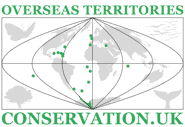Convention on Biological Diversity
The Convention on Biological Diversity signed by the UK Government at the Earth Summit in Rio de Janeiro, Brazil, in June 1992 sets out a list of actions for governments to pursue in order to conserve biological diversity and to ensure the sustainable use of those species and habitats being exploited by man, including the fair and equitable sharing of the benefits arising from the use of genetic resources (the Nagoya Protocol). The UK Government signed this Convention on behalf of the Kingdom, including its Overseas Territories and Crown Dependencies, but only a small number of these were included, at the request of their governments in the UK’s ratification of the CBD in June 1994: BVI, Cayman Islands, Gibraltar, Jersey, St Helena and its “Dependencies” (Ascension Island and Tristan da Cunha). Since then, the ratification has also been extended to the Isle of Man (2012), South Georgia and the South Sandwich Islands (2015), and the Falkland Islands (2016). Others are considering, and both UKOTCF, UK Government and other territories, especially the Isle of Man (the first to find the route to extension) have all provided advice, including at the UKOTCF/Gibraltar Conference 2015.
Contracting Parties are required to create and enforce national strategies and action plans to conserve, protect and enhance biodiversity. They are required also to undertake action to implement the thematic work programmes on ecosystems and a range of cross-cutting issues which have been established to take forward the provisions of the Convention. In October 2010, at the 10th Conference of the Parties to the CBD in Nagoya, Japan, the Parties adopted a new ‘Strategic Plan for Biodiversity 2011-2020′ along with its 20 ‘Aichi targets’. The latter set out 20 challenging targets under 5 strategic goals to stimulate “effective and urgent action to halt the loss of biodiversity in order to ensure that by 2020 ecosystems are resilient and continue to provide essential services, thereby securing the planet’s variety of life, and contributing to human well-being, and poverty eradication”. The goals and targets comprise both aspirations for achievement at the global level and a flexible framework for the establishment of national or regional targets.
The European Union adopted its own new EU Biodiversity Strategy in May 2011 to halt the loss of biodiversity and ecosystem services in the EU by 2020 as a contribution to meeting the goals of the Strategic plan and Aichi targets. UKOTCF personnel worked to ensure that this considered also the UKOTs. Within the UK, delivery of the CBD and the Strategic Plan is now guided by the UK Post-2010 Biodiversity Framework, which is overseen by the Environment Departments of all four domestic governments in Great Britain and Northern Ireland working together through the Four Countries Biodiversity Group. While the UK is ultimately accountable for the UKOTs meeting their environmental commitments, it is the governing bodies of those Territories who are responsible for ensuring that the appropriate actions are implemented and underpinned by enforceable legislation. A report published in 1998, edited by UKOTCF members, highlighted the comparative lack of attention given by the UK government to the biological diversity, resources and conservation thereof, of the UKOTs. However, since then, the UK government has acknowledged greater commitment to UKOT biodiversity conservation, starting with the signing of Environment Charters between UK government and UKOT governments in 2001. In 2016, UKOTCF published a review of progress of UKOTs in implementing their Environment Charters, including consideration of progress towards the Aichi Targets on biodiversity and the related Sustainable Development Goals.
